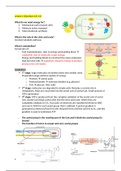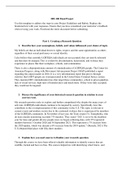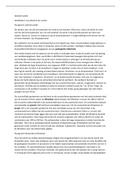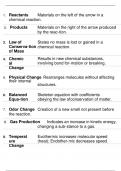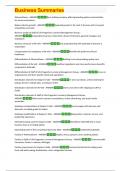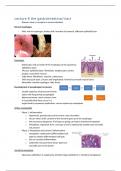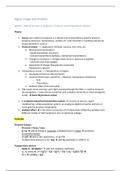Lesson 1 Glycolysis (ch. 14)
What do we need energy for?
1. Mechanical work (muscle cells)
2. Molecule active transport
3. Macromolecule synthesis
What is the role of the citric acid cycle?
Central metabolic pathway
What is metabolism?
Conversion of:
- Fuel (carbohydrates, fats) to energy and building block
catabolism (use of molecules to get energy)
- Energy and building blocks to construct the many molecules
that form the cells anabolism (requires energy to produce
products the cell needs)
Catabolism
Ú 1st stage: large molecules are broken down into smaller units.
Preparation stage without capture of energy
o Proteins amino acids
o Polysaccharides monosaccharides (e.g. glucose)
o Fats glucose, fatty acids.
nd
Ú 2 stage: molecules are degraded to simple units that play a central role in
metabolism. Most are converted into the acetyl unit of acetyl CoA. Small amount of
ATP is generated
Ú 3rd stage: ATP is produced from the complete oxidation of the acetyl unit of acetyl
CoA. Acetyl CoA brings acetyl units into the citric acid cycle, where they are
completely oxidized to CO2. Four pairs of electrons are transferred (three to NAD +
and one to FAD) for each acetyl group that is oxidized. A proton gradient is
generated as electrons flow from the reduced forms of these carriers to O 2, and this
gradient is used to synthesize ATP
The acetyl group is the reacting part of the CoA and it binds the acetyl group (in
brown)
The function of CoA is to accept and carry acetyl groups
1
,Cellular respiration one of the central metabolic routes
Ú Glycolysis (fig. 1) in the cytosol
o Glucose 2 pyruvate + ΔG (free energy)
o Preparatory phase
Investment of 2 ATP
Glucose has to be inside the cell
First reaction: phosphorylation
G3P is used for the next phase
o Payoff phase
“(2)” means that we are counting per
glucose molecule
Harvest 4 ATP
End product 2 pyruvate
o Learning goal: metabolites, enzymes, side
products and recognition of formula
Ú Pyruvate to acetyl CoA mitochondrion
Ú Citric acid cycle mitochondrion
Ú Respiratory chain/oxidative phosphorylation
mitochondrial membrane
Enzymes that play an important role in the glycolysis are: Figure 1: Glycolysis
1. Kinases: enzyme transfers phosphate group from ATP to another molecule
2. Dehydrogenases: belongs to oxidoreductases; catalyzes oxidative reactions
(NADH/FADH2 forming)
3. Isomerases: catalyzes structural isomerization (mutase shifts phosphate groups)
4. Enolases: enzyme of the lyase class (carbo-oxygen bond cleavage)
The intermediate step: conversion
For 1 glucose molecule: 2 pyruvate + 2 CoA + 2 NAD+ 2 Acetyl-CoA + 2 CO2 + 2 NADH +
2H+
This intermediate reaction is catalyzed through an enzyme the pyruvate dehydrogenase
Requires 5 coenzymes
o TPP, lipoyl lysine and FAD are catalytic cofactors. These compounds are
regenerated, and so, not wasted in every cycle.
o NAD+ and CoA-SH are stoichiometric cofactors. These compounds are being
used as substrates.
Cofactors are small molecules that assist mainly enzymes in their catalytic activity
Metals: e.g. Fe2+, Mg2+, Zn2+
Small organic molecules (coenzymes)
o Tightly bound (prosthetic groups)
o Loosely bound (co-substrates)
Apoenzyme + cofactor = holoenzyme
Glycolysis: Glu + 2 ADP + 2 Pi + 2 NAD+ 2 pyruvate + 2 ATP + 2 NADH + 2 H2O + 2 H+
2
, Intermediate step/pyruvate to acetyl CoA: 2 pyruvate + 2 CoA + 2 NAD+ 2 Acetyl-CoA + 2 CO2
+ 2 NADH + 2 H+
Lesson 2 Citric acid cycle, respiratory chain and oxidative
phosphorylation (ch. 16 & 19)
Citric acid cycle
Ú Cyclic pathway
o CO2 production
Ú Substrate level ATP
Ú NADH stores high energy electrons
o Oxidation of alcohol or oxidative decarboxylation
Ú QH2 stores high energy electrons
o Alkane reduction to Pi bond
Ú Decisive step where the cell is capable of going to burn the fuels with oxygen
Ú Important source of building blocks (amino acids,
nucleotides, bases, etc.)
Ú A 4-carbon compound (oxaloacetate)
condensates with a 2-carbon acetyl unit to give a
6-carbon tri-carboxylic acid
Step 1: citrate synthase forms citrate from oxaloacetate
and acetyl coenzyme A. The CoA bond is a high energy
bond; therefore, the hydrolysis of this bond drives the
reaction to the right
Step 2: citrate is isomerized into isocitrate. By
dehydration and hydration, the hydroxyl group is placed
on a different C-atom
Step 3: isocitrate is oxidized and decarboxylated to alpha
ketoglutarate. This is the reason why the hydroxyl group has been replaced. The isocitrate
undergoes 2 reactions; The first one is the redox reaction, where 1 NADH is being produced.
The second one is the decarboxylation. The blue
highlighted atom will leave isocitrate, which gives us CO2
Step 4: succinyl coenzyme A is formed by the oxidative
alpha ketoglutarate. This is an oxidative decarboxylation
reaction, namely, the formation of succinyl-CoA and CO2.
This produces 1 NADH. The bound group of the CoA makes this compound (succinyl-CoA) a
high energy compound. This high energy compound can
drive the reaction of an ATP molecule
Step 5: succinyl CoA synthetase transfers a Pi group to
ADP/GDP. Succinyl-CoA has enough energy to drive a
reaction of ADP/GDP into ATP/GTP to the right
3
What do we need energy for?
1. Mechanical work (muscle cells)
2. Molecule active transport
3. Macromolecule synthesis
What is the role of the citric acid cycle?
Central metabolic pathway
What is metabolism?
Conversion of:
- Fuel (carbohydrates, fats) to energy and building block
catabolism (use of molecules to get energy)
- Energy and building blocks to construct the many molecules
that form the cells anabolism (requires energy to produce
products the cell needs)
Catabolism
Ú 1st stage: large molecules are broken down into smaller units.
Preparation stage without capture of energy
o Proteins amino acids
o Polysaccharides monosaccharides (e.g. glucose)
o Fats glucose, fatty acids.
nd
Ú 2 stage: molecules are degraded to simple units that play a central role in
metabolism. Most are converted into the acetyl unit of acetyl CoA. Small amount of
ATP is generated
Ú 3rd stage: ATP is produced from the complete oxidation of the acetyl unit of acetyl
CoA. Acetyl CoA brings acetyl units into the citric acid cycle, where they are
completely oxidized to CO2. Four pairs of electrons are transferred (three to NAD +
and one to FAD) for each acetyl group that is oxidized. A proton gradient is
generated as electrons flow from the reduced forms of these carriers to O 2, and this
gradient is used to synthesize ATP
The acetyl group is the reacting part of the CoA and it binds the acetyl group (in
brown)
The function of CoA is to accept and carry acetyl groups
1
,Cellular respiration one of the central metabolic routes
Ú Glycolysis (fig. 1) in the cytosol
o Glucose 2 pyruvate + ΔG (free energy)
o Preparatory phase
Investment of 2 ATP
Glucose has to be inside the cell
First reaction: phosphorylation
G3P is used for the next phase
o Payoff phase
“(2)” means that we are counting per
glucose molecule
Harvest 4 ATP
End product 2 pyruvate
o Learning goal: metabolites, enzymes, side
products and recognition of formula
Ú Pyruvate to acetyl CoA mitochondrion
Ú Citric acid cycle mitochondrion
Ú Respiratory chain/oxidative phosphorylation
mitochondrial membrane
Enzymes that play an important role in the glycolysis are: Figure 1: Glycolysis
1. Kinases: enzyme transfers phosphate group from ATP to another molecule
2. Dehydrogenases: belongs to oxidoreductases; catalyzes oxidative reactions
(NADH/FADH2 forming)
3. Isomerases: catalyzes structural isomerization (mutase shifts phosphate groups)
4. Enolases: enzyme of the lyase class (carbo-oxygen bond cleavage)
The intermediate step: conversion
For 1 glucose molecule: 2 pyruvate + 2 CoA + 2 NAD+ 2 Acetyl-CoA + 2 CO2 + 2 NADH +
2H+
This intermediate reaction is catalyzed through an enzyme the pyruvate dehydrogenase
Requires 5 coenzymes
o TPP, lipoyl lysine and FAD are catalytic cofactors. These compounds are
regenerated, and so, not wasted in every cycle.
o NAD+ and CoA-SH are stoichiometric cofactors. These compounds are being
used as substrates.
Cofactors are small molecules that assist mainly enzymes in their catalytic activity
Metals: e.g. Fe2+, Mg2+, Zn2+
Small organic molecules (coenzymes)
o Tightly bound (prosthetic groups)
o Loosely bound (co-substrates)
Apoenzyme + cofactor = holoenzyme
Glycolysis: Glu + 2 ADP + 2 Pi + 2 NAD+ 2 pyruvate + 2 ATP + 2 NADH + 2 H2O + 2 H+
2
, Intermediate step/pyruvate to acetyl CoA: 2 pyruvate + 2 CoA + 2 NAD+ 2 Acetyl-CoA + 2 CO2
+ 2 NADH + 2 H+
Lesson 2 Citric acid cycle, respiratory chain and oxidative
phosphorylation (ch. 16 & 19)
Citric acid cycle
Ú Cyclic pathway
o CO2 production
Ú Substrate level ATP
Ú NADH stores high energy electrons
o Oxidation of alcohol or oxidative decarboxylation
Ú QH2 stores high energy electrons
o Alkane reduction to Pi bond
Ú Decisive step where the cell is capable of going to burn the fuels with oxygen
Ú Important source of building blocks (amino acids,
nucleotides, bases, etc.)
Ú A 4-carbon compound (oxaloacetate)
condensates with a 2-carbon acetyl unit to give a
6-carbon tri-carboxylic acid
Step 1: citrate synthase forms citrate from oxaloacetate
and acetyl coenzyme A. The CoA bond is a high energy
bond; therefore, the hydrolysis of this bond drives the
reaction to the right
Step 2: citrate is isomerized into isocitrate. By
dehydration and hydration, the hydroxyl group is placed
on a different C-atom
Step 3: isocitrate is oxidized and decarboxylated to alpha
ketoglutarate. This is the reason why the hydroxyl group has been replaced. The isocitrate
undergoes 2 reactions; The first one is the redox reaction, where 1 NADH is being produced.
The second one is the decarboxylation. The blue
highlighted atom will leave isocitrate, which gives us CO2
Step 4: succinyl coenzyme A is formed by the oxidative
alpha ketoglutarate. This is an oxidative decarboxylation
reaction, namely, the formation of succinyl-CoA and CO2.
This produces 1 NADH. The bound group of the CoA makes this compound (succinyl-CoA) a
high energy compound. This high energy compound can
drive the reaction of an ATP molecule
Step 5: succinyl CoA synthetase transfers a Pi group to
ADP/GDP. Succinyl-CoA has enough energy to drive a
reaction of ADP/GDP into ATP/GTP to the right
3


